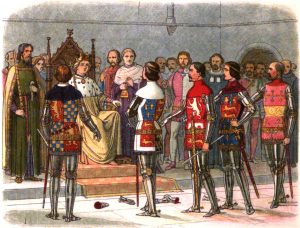
When I first bumped into the Lords Appellant I was confused because as far as I knew, an appeal was filed after a court conviction in an attempt to reverse the decision. But as it turns out, in the fourteenth century an appeal was the starting point—an indictment or an accusation against someone, initiating a legal procedure. What made the case of the Lords Appellant so special was that this was the first time the appeal was introduced into Parliament; up until then, it was used in common and civil courts.
When you see the words Lords Appellant capitalized, it refers to those involved in the first legal crisis of Richard II’s reign. Their case was against Richard’s friends, counselors, and officers who were accused of giving the king bad advice—misleading and deceiving him. Most historians agree that the Appellants were driven by resentment, ambition, and dissatisfaction. Here they were, some of the most powerful magnates in the realm, shut out of Richard’s inner circle. No influence with the king, no power, no opportunities to reward their retainers—all these obstacles put them in a bad position. However, they weren’t powerful enough to go after Richard directly; there was no popular swell of discontent as in the case of Edward II. The second best solution was to eliminate the king’s despised supporters and get him under their control.
The only person that stood between the Appellants and the king was John of Gaunt, the eldest surviving son of Edward III and a stickler for protocol. However, in 1386 when he sailed for Spain to pursue a crown of his own, his absence left Richard exposed to his enemies. They immediately went on the offensive and the young king was too inexperienced to know how to deal with them. Nonetheless, the Lords Appellant had a problem. If they went through the courts, the rulings wouldn’t be permanent enough. The only way to completely destroy their enemies, take away their titles, lands—even their lives—and dispossess the heirs was through Parliament. Not only were their motives questionable, but the whole process had no legal basis from which to act, and the Appellants were forced to make up the rules as they went along, twisting the system to accommodate their self-serving objectives.
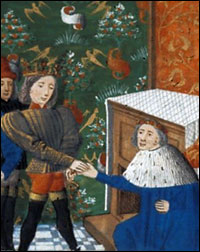
The driving force behind the Lords Appellant was Thomas of Woodstock, 1st Duke of Gloucester (the youngest son of Edward III). One would think that the king’s uncle would not be his worst enemy, but Gloucester was a bitter, aggressive man. He reminds me of John Lackland because he, too, came out on the losing end of land distribution after all his siblings were taken care of. He only became duke two years before all this unpleasantness started, and even so he was dependent on the exchequer for his revenue. If it weren’t for his wife, one of the great Bohun heiresses, he would have had nothing at all. His only hope of prominence would have been from the French wars like his brother the Black Prince and his father Edward III; but here, too, the king disappointed him. There was to be no major campaigning in this reign, and Gloucester became the spokesman for warmongers amongst his peers. As the Appellants gained the upper hand, Gloucester even went so far as to put himself forward as a possible replacement (after having deposed Richard), but young Henry of Bolingbroke put an end to that scheme. There were stronger claimants to the throne, himself included.
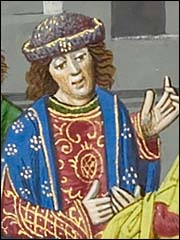
In almost total accord with Gloucester, Richard FitzAlan, 11th Earl of Arundel was a stout collaborator. He was an experienced, if unexceptional warrior and served under John of Gaunt, mostly as admiral. Although he won brief popularity by sharing a year’s worth of wine with all of England at rock-bottom prices (from 100 captured Flemish vessels), his brusque and overbearing personality made him few friends. From the beginning of Richard’s reign he was on the council of regency, and in 1381 he was appointed co-councilor in constant attendance upon the young king, ironically alongside his future victim Michael de la Pole. Although Richard warmed up to Michael he found Arundel detestable, which I suspect contributed to the crisis.
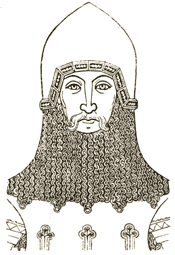
The third original Appellant was Thomas de Beauchamp, 12th Earl of Warwick. He was the son of the famous Thomas Beauchamp known for his bravery at Crecy and Poitiers. Rather mediocre and undistinguished, Thomas never lived up to his father’s reputation. But he was, after all, a noble from a great family and hence valuable as an ally. He pretty much went along with everything Gloucester said and didn’t rock the boat.
The three Appellants originally appealed five of Richard’s supporters: Michael de la Pole, Earl of Suffolk and chancellor of England, Robert de Vere, Earl of Oxford and Richard’s closest friend, Robert Tresilian, Chief Justice of the King’s Bench, Sir Nicholas Brembre, wealthy London magnate and former Mayor, and Alexander Neville, Archbishop of York. After the Lords Appellant made their formal appeal, Richard arranged for Neville, de la Pole, and Tresilian to slip away, and secretly sent Robert de Vere to Cheshire to raise an army to defend him. Brembre stayed put, certain of his innocence, and sought to gain support in London for the king (he paid for that with his life).
Once the Appellants discovered that de Vere was putting together an army, the last two “junior” members came on board. Henry of Bolingbroke, Earl of Derby (son of John of Gaunt and the future Henry IV) posted himself at Radcot Bridge and succeeded in blocking de Vere from crossing the Thames; the royal army dispersed after a brief and pathetic battle and de Vere escaped over the Channel. Why did the non-political Bolingbroke join the Appellants? He later claimed he needed to protect this father’s interests. It’s also difficult to discover the motives of Thomas de Mowbray, Earl of Nottingham, 1st Duke of Norfolk (great-great grandson of Edward I and son-in-law to Arundel). He could have been driven by jealousy of Robert de Vere, who supplanted him in Richard’s esteem. His early friendship with the king had definitely cooled, especially after he married Arundel’s daughter; I imagine his father in-law put pressure on him to join the party of resistance. These last two Appellants tended to take a back seat, so to speak, and never wholeheartedly agreed with all the knavery that attended these trials. Nonetheless, they were committed and so the three became five.
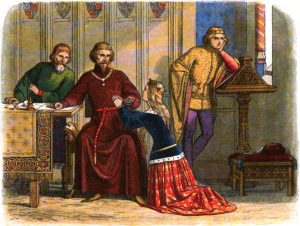
From besieging the king in the Tower of London to the Merciless Parliament of 1388, the Lords Appellant pursued a bloody campaign against the king’s supporters, culminating in the outrageous execution of Sir Simon Burley, Richard’s vice-chamberlain and lifelong mentor. (By then they had gone way beyond their initial condemnations.) Bolingbroke and Mowbray publicly objected to Burley’s conviction, as well as the Duke of York, Gloucester’s brother; even Queen Anne got on her knees and begged Gloucester for Burley’s life, to no avail. In the end, eight of Richard’s supporters were executed—for no good reason. Three more fled to permanent exile, and over forty others were ejected from court (some returned later as Richard took back his authority). The king was reduced to a figurehead and withdrew to lick his wounds. For one year the three original Appellants tried to run the government their way (Bolingbroke and Mowbray had lost interest by then), but it soon became obvious that they were doing no better than before. Worse, actually: it was under their watch that the disastrous Battle of Otterburn was lost and Henry Hotspur taken prisoner along with his brother Ralph. Their ransom was a huge hit to the already depleted exchequer, which had been obliged to pay the Lords Appellant 20,000 pounds to reimburse them “for their great expenses in procuring the salvation of the realm and the destruction of the traitors”.
When Richard declared his majority in 1389, he was able to take over and dismiss his enemies without a protest. But, though Richard was obliged to “forgive and forget” on the surface, in reality his anger festered for ten years until he was strong enough to wreak revenge on the men who humiliated him.
You can read more about the Lords Appellant in my novel A KING UNDER SIEGE.